
Web Developers
Executive summary
Aging brings with it many changes, often including disability due to frailty or illness. While some seniors are able to care for themselves at home, others experience conditions that constrain their mobility or leave them housebound. In the US and the UK, the most common disability among seniors is constrained mobility. Despite the prevalence of disability, there is an increasing preference among seniors across the globe to “age in place” by remaining in their homes through the later stages of life instead of moving to institutions, even if they need healthcare or assistance with everyday tasks. Given many seniors’ preference to age in place and their high rates of mental and physical challenges due to mobility issues, companies have been developing a range of technologies that cater to this population’s needs. Innovative products and services are providing seniors with assistance in mobility and everyday living, helping them keep in touch with family and friends, learn new skills or teach them to others, and pursue hobbies and find companions. Developments in robotics and smart homes are addressing seniors’ physiological, social and safety needs, while creative virtual-learning networks are helping them learn new things and share their own knowledge. Meanwhile, social networks are helping them find companions, thus helping to meet their social and self-esteem needs. Such technology is not only enabling many seniors around the world to live independently for longer, but also enhancing their quality of life.Introduction: tech’s value to mobility-constrained seniors
We live in an age when most of us are almost always digitally connected—either to other people or to some form of media, such as online video content or mobile apps. Although seniors are typically less likely than other age groups to use new technology, the connections it can provide are even more important for them than they are for younger people, as their mobility problems may prevent them from living an active life and interacting often with others face to face. Many new forms of technology can keep housebound seniors in touch: for example, smartphones and tablets allow instant connectivity between people who wish to communicate with each other, putting loved ones and friends just a phone call (or email or chat message) away. In senior care, technology has found numerous applications that not only enable seniors to get faster and more immediate assistance when needed, but also help them lead a better quality of life. As we showed in our previous reports in the Silvers Series, wearable devices can help seniors monitor their own health and help caregivers track the well-being of those in their care. These devices also fulfill safety and security functions, helping caregivers and others track the whereabouts and activities of the wearer. [caption id="attachment_91080" align="aligncenter" width="370"] Source: Shutterstock[/caption]
This is the third report in our Silvers Series. So far, we have looked at healthcare technology and homecare for seniors. In this report, we examine the technology that is enabling seniors who are mobility constrained due to physical or mental conditions—those who are housebound or otherwise unable to lead fully independent lives—to remain connected and rely less on the assistance of others. Such technology is slowly becoming a welcome addition to seniors’ lives, enabling greater independence and aging in place.
The following sections of this report consider the conditions that may lead to seniors becoming housebound or mobility constrained, the kind of physical and emotional needs that mobility-constrained people have, and the technology that is either already on the market or is being developed to help silvers who have mobility issues. Our discussion of the potential offered by new technologies focuses on five themes:
Source: Shutterstock[/caption]
This is the third report in our Silvers Series. So far, we have looked at healthcare technology and homecare for seniors. In this report, we examine the technology that is enabling seniors who are mobility constrained due to physical or mental conditions—those who are housebound or otherwise unable to lead fully independent lives—to remain connected and rely less on the assistance of others. Such technology is slowly becoming a welcome addition to seniors’ lives, enabling greater independence and aging in place.
The following sections of this report consider the conditions that may lead to seniors becoming housebound or mobility constrained, the kind of physical and emotional needs that mobility-constrained people have, and the technology that is either already on the market or is being developed to help silvers who have mobility issues. Our discussion of the potential offered by new technologies focuses on five themes:
- Robotics
- Tech and applications
- Virtual learning
- Social networks
- Smart homes
Understanding The prevalence of mobility-constrained seniors
A person’s mobility may be constrained by a disability brought about by an infectious disease, a chronic condition, an injury or frailty that accompanies the natural aging process. In this section, we explore the nature and scale of the mobility-constraint issue. Before we look at some key figures, it is worth noting that major studies on this issue by the World Health Organization (WHO) and national statistics offices are typically conducted infrequently, so the latest available data are often from several years earlier. Nevertheless, they provide the best available indicators of prevalence. The WHO’s 2011 World Report on Disability cited a key figure from the organization’s last World Health Survey, which was completed in 2004: 15.6% of the world’s population that year had a moderate to severe disability. That equates to about 650 million people, given that the global adult population was approximately 4.2 billion in 2004. About 248 million people aged 60 and over had a disability in that year, we estimate from the survey, equivalent to 38.1% of all disabled adults. The survey found that disability prevalence among seniors in lower-income countries was much higher than in higher-income countries (43.4% versus 29.5%). [caption id="attachment_91081" align="aligncenter" width="357"] Participants in the WHO’s survey were asked to score their difficulties in functioning. The average score for all these groups—those reporting extreme difficulties and those reporting chronic diseases—was around 40, with a range from 0 (no functioning difficulty) to 100 (complete difficulty). Therefore, 40 was chosen as the threshold point between “disabled” and “not disabled” for all survey respondents
Participants in the WHO’s survey were asked to score their difficulties in functioning. The average score for all these groups—those reporting extreme difficulties and those reporting chronic diseases—was around 40, with a range from 0 (no functioning difficulty) to 100 (complete difficulty). Therefore, 40 was chosen as the threshold point between “disabled” and “not disabled” for all survey respondentsSource: WHO, World Report on Disability (2011)[/caption]
In Focus: The US and the UK
In the US in 2014, about 36% of those aged 65 and over, or approximately 15.5 million people in that age group, reported experiencing some kind of disability. The most common type of disability was mobility or ambulatory difficulty, experienced by 23.0% of seniors, or 3.6 million people, according to the American Community Survey (ACS), conducted by the US Census Bureau. The second-most-common type of disability was independent living difficulty, experienced by 15.2% of the group. This refers to difficulty with running errands, such as shopping or going to the doctor, alone. Some respondents to the survey reported experiencing more than one disability. [caption id="attachment_91082" align="aligncenter" width="371"] Percentages do not sum to 100, as a person may experience more than one disability.
Percentages do not sum to 100, as a person may experience more than one disability.Source: US Census Bureau, American Community Survey (2014)[/caption] The definitions of the various disabilities used by the ACS are listed below. [caption id="attachment_91086" align="aligncenter" width="565"]
 Source: US Census Bureau, American Community Survey (2014)[/caption]
In the UK, meanwhile, more than one-quarter of silvers have reported chronic health problems related to their muscles, bones, heart or circulation:
Source: US Census Bureau, American Community Survey (2014)[/caption]
In the UK, meanwhile, more than one-quarter of silvers have reported chronic health problems related to their muscles, bones, heart or circulation:
- According to the UK’s 2007 General Household Survey, 27.3% of people aged 65–74 and 33.3% of those aged 75 and over reported experiencing long-term conditions that affect the musculoskeletal system. These include joint pain, arthritis and osteoporosis—which can significantly affect one’s mobility.
- Conditions affecting the heart and circulatory system were reported by 27.7% of those in the 65–74 age group and by 30.1% of those 75 and over.
- Chronic problems related to other conditions, such as respiratory problems, were far less common among those polled. However, taken together, they were significant, indicating that a sizeable proportion of seniors were enduring long-standing health issues.
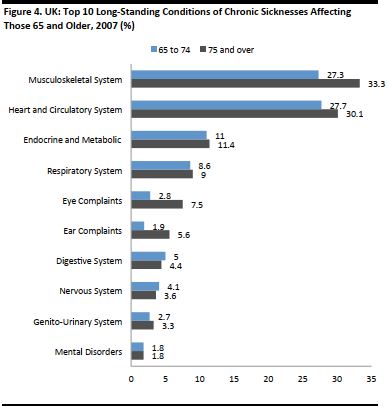 Source: Office for National Statistics (ONS)[/caption]
While some people with disabilities may be able to carry out certain activities of daily living on their own, they may need assistance from caregivers or to modify their homes to make them more accessible. As we show later, these two traditional means of assistance have been joined by a series of technological innovations that are allowing disabled silvers to lead more independent lives.
Source: Office for National Statistics (ONS)[/caption]
While some people with disabilities may be able to carry out certain activities of daily living on their own, they may need assistance from caregivers or to modify their homes to make them more accessible. As we show later, these two traditional means of assistance have been joined by a series of technological innovations that are allowing disabled silvers to lead more independent lives.
Aging in Place Trend Prompts Demand for innovations that enable independent living
In-home care is becoming more prevalent among those who have long-term health conditions. As we noted earlier, seniors are showing an increasing preference to age in place—to remain in their own homes and receive care there, instead of moving to a residential institution. In 2013, there were approximately 4.6 million senior long-term care (LTC) recipients, who needed either institutional care or in-home care, in the 10 countries for which the OECD reports such metrics. A majority of these seniors are likely to have experienced some form of mobility constraint. Changes in the proportion of seniors receiving LTC in either an institution or at home in 2000 versus in 2013 (latest available data) show that there was a considerable shift in the countries examined by the OECD. In fact, the change in the average proportion of seniors receiving in-home care was more significant (a 6.2-percentage-point increase) than the change in the average proportion of seniors receiving institutional care (a 1.8-percentage-point decrease). [caption id="attachment_91088" align="aligncenter" width="371"]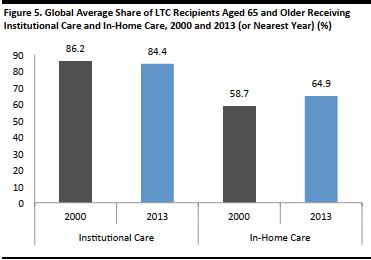 The average is of 10 OECD countries (Finland, Germany, Hungary, Japan, Luxembourg, the Netherlands, Norway, Sweden, Switzerland and the US) that reported data on the proportion of seniors aged 65 and older who were receiving each form of care.
The average is of 10 OECD countries (Finland, Germany, Hungary, Japan, Luxembourg, the Netherlands, Norway, Sweden, Switzerland and the US) that reported data on the proportion of seniors aged 65 and older who were receiving each form of care.Source: OECD/Fung Global Retail & Technology[/caption]
The Needs of Seniors Who Are Aging in Place
As more seniors age in place, many will be living independently. They may not always have access to assistance when they experience difficulties, such as an inability to run errands due to a mental condition, an inability to do regular household chores due to limited mobility, or an inability to be as socially active as they once were. Several studies have indicated that being isolated in later age can have a detrimental effect on a person’s mental and physical well-being, and increase the risk of developing further health conditions. With people’s needs varying according to their life stage and circumstances, healthcare organizations, social groups and innovators have created products, services and activities that can serve the unique needs of mobility-constrained people, and so facilitate their inclusion in society. Using psychologist Abraham Maslow’s hierarchy of needs theory as a base, we group the needs of mobility-constrained seniors into four themes, on a scale that runs from basic survival to emotional satisfaction: physiological needs, safety and security needs, social needs and self-esteem needs. [caption id="attachment_91089" align="aligncenter" width="537"]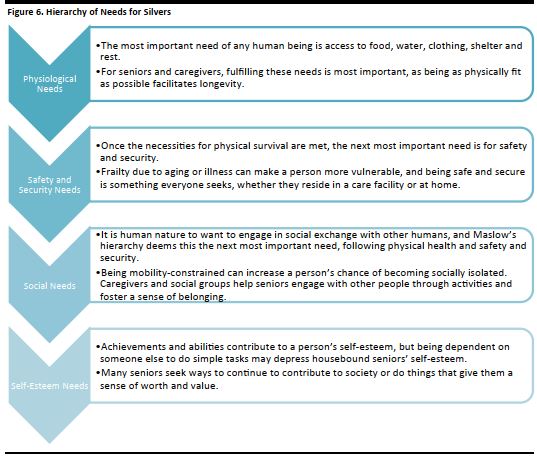 Source: Fung Global Retail & Technology[/caption]
For new concepts, innovations and activities to become popular and successful, they must fulfill these needs of elderly people, helping them lead not only longer lives, but also better-quality lives. In the next section, we consider how new developments are helping silvers lead better lives by fulfilling these various needs.
Source: Fung Global Retail & Technology[/caption]
For new concepts, innovations and activities to become popular and successful, they must fulfill these needs of elderly people, helping them lead not only longer lives, but also better-quality lives. In the next section, we consider how new developments are helping silvers lead better lives by fulfilling these various needs.
New Technologies and Innovations
Advances in robotics and the Internet of Things (IoT), and the widespread use of social media, have contributed to the creation of solutions for seniors. Below, we identify five segments that are catering to silvers in new ways. [caption id="attachment_91090" align="aligncenter" width="536"]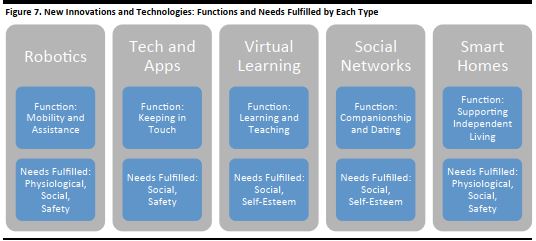 Source: Fung Global Retail & Technology[/caption]
Source: Fung Global Retail & Technology[/caption]
Robotics: Mobility and Assistance
The development of robotics for use in assisting seniors has been somewhat limited to date, but there have been a few notable advances in terms of robotic limbs and exoskeletons, as well as in “social” robots: Robotic arms and legs: SRI International, a nonprofit, independent research center, launched a venture called Superflex in April 2016. Superflex has developed a supportive robotic suit, essentially a soft exoskeleton, that can fit snugly over a person’s body and help him or her walk, maintain good posture and move objects. It is designed to enable frail seniors and disabled people to carry out everyday tasks. [caption id="attachment_91091" align="aligncenter" width="292"]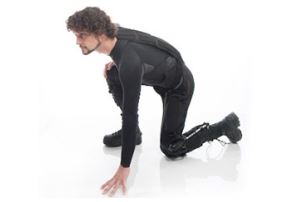 Superflex’s robotic exoskeleton
Superflex’s robotic exoskeleton Source: Sri.com[/caption] Japanese company Cyberdyne is trialing robotic arms and legs that can be fitted onto a person/part of the body that is disabled in order to enable the person to move independently and carry out activities of daily living on their own. [caption id="attachment_91092" align="aligncenter" width="354"]
 Cyberdyne’s robotic legs
Cyberdyne’s robotic legsSource: Cyberdyne.jp[/caption] A group of scientists from seven universities across the UK is working on smart/robotic trousers and socks that enable mobility in vulnerable seniors and disabled people. The trousers will use a combination of bionics, reactive polymers and artificial “muscles” to help the user move independently and reduce the chance of falling.
- Humanoid robot homecare assistants: Jibo is billed as “the world’s first social robot for the home,” and is positioned as a product suitable for elderly people. The robot can “see, hear, speak and help” and can be used as an emergency communication tool. Jibo also serves as a companion, which is appealing to many seniors, who oftentimes live on their own. The robot was originally an Indiegogo project that raised $3.7 million. Jibo’s developers have now created a full-fledged company that has attracted over $52.3 million in funding.
 The Jibo social robot
The Jibo social robotSource: Jibo.com[/caption] Honda has developed a humanoid robot called Asimo, whose applications range from industrial uses—it can function as a warehouse assistant that lifts and moves heavy loads—to being a home helper. It is also designed to help pick up and store things, turn switches on and off, and push doors and carts. The Riken institute in Japan has also developed a humanoid robot, one whose primary function is to assist disabled and older people. The Robear nursing-care robot can help lift people from a bed and place them in a chair or in a bath, and vice versa. [caption id="attachment_91094" align="aligncenter" width="372"]
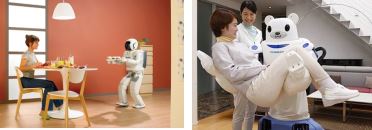 The Asimo and Robear robots
The Asimo and Robear robotsSource: Yalescientific.org/Theguardian.com[/caption]
Tech and Apps: Keeping in Touch
Mainstream mobile phones, tablets and computers usually come loaded with so many features and applications that some seniors feel overwhelmed by them. To better meet silvers’ need for technology solutions, some companies have developed hardware and software specifically for the senior population, allowing them to connect with others around the world and view content that interests them. Notable players in this market include:- It’s Never 2 Late (iN2L): iN2L is a US-based company that provides seniors with technology—tablets, computers and televisions that are preloaded with the company’s customized software—that is easy to use and useful. Its system, consisting of hardware, software and other components, is based on touch-screen, picture-based applications that allow those with even limited computer experience to operate the devices easily.
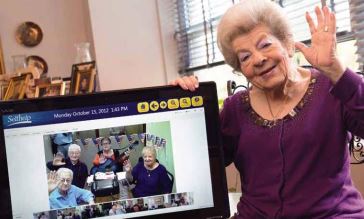 The Virtual Senior Center
The Virtual Senior CenterSource: Servingseniors.org[/caption]
- Zone V: Zone V was founded by Dr. Peter Ashall, formerly head of the Vertu business unit at Nokia. The company plans to produce a smartphone for people with limited eyesight, hearing or dexterity. It is now in the final preparation stage, following three years of development.
- 21KE: 21KE is one of the popular cell phone manufacturers on China’s e-commerce site JD.com. The company develops cell phones for seniors, and has already released four models. The phones by 21KE run on their own proprietary operating system, Care OS, which has over 65 customized features catering to the needs of seniors. The company received funding from Xiaomi, one of the largest Chinese smartphone manufacturers, in 2015. The move will help Xiaomi capture the promising seniors market.
- RealPad: In the US, the AARP (formerly the American Association of Retired Persons), a nonprofit social welfare agency, developed a tablet called the RealPad that is specifically designed for silvers. The device comes with preloaded apps and large graphics and icons, which make it easy for older people to use.
- Elderis: Elderis offers an interactive portal, accessible via smart TV or touchpad, that is available for use in private homes and institutions. The company advertises that its portal serves most of the needs of seniors, promoting well-being, comfort and prevention and helping them keep in touch with loved ones. Key features include communication (sending and receiving text, email, photos and videos), on-demand content (audio, video and neighborhood information), scheduling and notifications, and inactivity detection through sensors connected in the home.
Virtual Learning: Learning and Teaching
Several initiatives have been developed that enable seniors to continue learning as they age. Still others help seniors teach other people through virtual learning centers, either from their home or from a residential care facility.- The Speaking Exchange project was created by advertising agency FCB Brasil and an English-language school called CNA to help the school’s students in Brazil connect with American retirees who can tutor them in speaking English. The idea was conceived to help the students learn from native English speakers, while giving the retirees an opportunity to teach through social interaction.
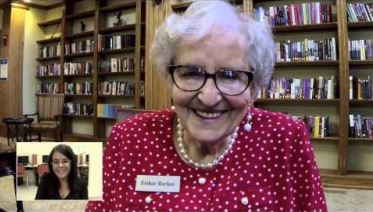 Source: Cna.com.br[/caption]
Source: Cna.com.br[/caption]
- Senior Learning Network (SLN) is a membership-based program that offers courses to seniors virtually. Seniors can enroll in courses that they are interested in, and attend them from their home or from a senior center. They can also choose to conduct classes and share their knowledge or hobby with other members of the program.
Social Networks: Companionship and Dating
Social networks are usually developed to connect people who may have common interests or to help them stay in touch with friends or other contacts. Adjacent to the social network space are online platforms for companionship and dating. While there is nothing to exclude seniors from using popular social networks such as Facebook, there are a number of social media applications that have been specifically designed for seniors:- Stitch is an online social-networking platform that aims to help seniors find companions. Different from most dating sites, it is not limited to singles; seniors can use the site to find travel companions, group activities, dinner dates or romantic partners. Users can register for free and enjoy limited services or pay a yearly subscription fee for more privileges. The service is currently available in English only, and its users are mainly from the US and Australia.
- Lao Lao is a Chinese social-networking app targeting seniors. It has two versions, one for seniors and one for their grown sons and daughters. The senior version helps seniors track their exercise, follow interest groups and share photos with their children. It aims to solve common issues for seniors living in cities, such as loneliness and boredom. The version for sons and daughters provides them with their parents’ health data as well as the content generated by their parents.
- In the US, the Connected Living program leverages technology to create an environment for older adults in senior housing to enjoy greater social interaction. It enables them to connect with loved ones and provides open access to community, educational and healthcare resources. The program has signed up over 60,000 users in 36 US states over the past seven years.
- Telephone befriending groups involve individuals who make telephone calls to housebound seniors and engage them in lively conversation. These are usually conducted by local councils, support groups and charitable organizations to help ensure that seniors are not isolated from society.
Smart Homes: Assisting Independent Living
Sensors and the IoT are finding numerous applications in senior care, and are particularly helpful for patients with dementia, who may need to be reminded to take their medication or turn off appliances. Smart devices can also notify caregivers about seniors’ safety and whereabouts. Most smart devices in a connected home, such as security cameras, fridges, lights, thermostats and TVs, can be programmed to function in a manner suitable to the person living in the home. They can help keep seniors safe and reduce their dependence on assistance from caregivers. Products and systems in the smart home segment include:- Sensor alert systems: Companies such as Lively, Evermind and BeClose place discreet sensors for wireless monitoring in homes. The sensors allow adult children to monitor their aging parents, and to offer help if needed. Sensors can be attached to items as small as pill containers and the collected data is recorded in a digital log that can be reviewed by relatives or caregivers.
- Fully integrated smart home systems: AT&T’s Digital Life offering includes an alarm system, door locks and cameras for the home, and is designed to be simple enough to be used by those who are not especially tech savvy. In the future, systems similar to Digital Life will be able to sync with wearable devices that track the health conditions of seniors who live in smart homes.
- Other smart devices that function as part of an integrated system in the home include Samsung’s SmartThings and Nest’s Thermostat. Smoke alarms and compatible devices from other makers can also be set up and customized to help ensure seniors’ safety and allow them to live more independently.
 Smart home devices
Smart home devices Source: Usatoday.com/Mercurynews.com[/caption]
Key Takeaways
More and more seniors want to be able to age in place, to remain in their own homes as they age, even if they are not able to care for themselves. The opportunities to serve this group are not confined to providing care services. New technologies can play a significant role in raising the standards of everyday life for mobility-constrained seniors:- Robotics: Innovations in robotics are helping seniors be more mobile, and care robots, such as Jibo and Robear, are providing them with assistance with everyday tasks.
- Tech and apps: Communications technologies tailored to the needs of silvers are helping more of them stay in touch with family, friends and loved ones.
- Virtual learning: Virtual learning centers are helping seniors learn and share knowledge through online classes, whether from their own private home or a residential care facility.
- Social networks: Social and dating apps and online platforms created for seniors are helping them find romantic partners and companions for activities such as travel, classes and hobbies.
- Smart homes: IoT devices and systems are helping fulfill a range of functions for seniors living independently, reminding them to take medication, providing home security and reducing their dependence on caregivers.